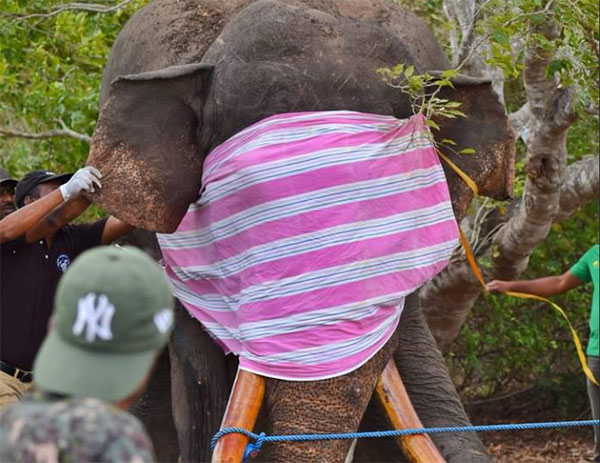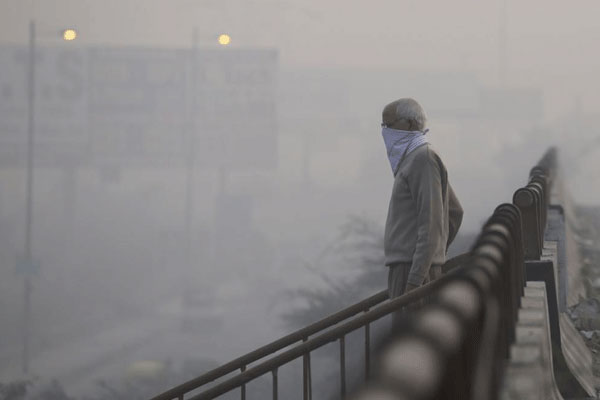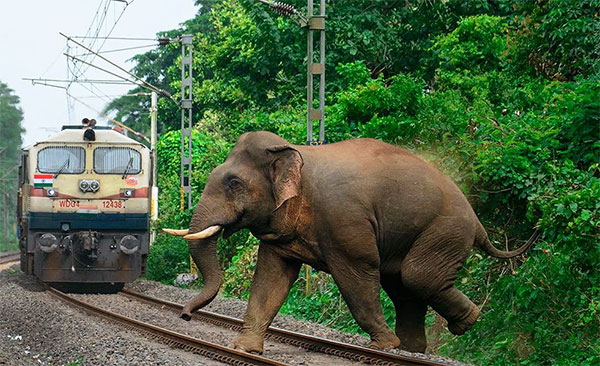ANURADHAPURA, Sri Lanka — “He is a king without a crown.” This is how wildlife lovers refer to the majestic elephant Agbo, named after a king from an ancient kingdom of humans overlapping with some areas of Agbo’s home range in north-central Sri Lanka.
Agbo is among the largest Sri Lankan tuskers, so there was no challenge for him in the wilderness, but one fateful day, Agbo fell victim to a trap gun set by a hunter.
Agbo’s left front leg was severely injured when a trap gun went off, making it difficult and painful for the elephant to move. Image courtesy of Dinuka Munasinghe.
Several metal pellets penetrated Agbo’s left front leg, making it hard to move. Agbo, a beast known for its majestic appearance and movements, was making painful ugly hops to move forward. Noticing the elephant’s plight, villagers in Thirappane (where Agbo was shot) notified the local office of the Department of Wildlife Conservation (DWC), which quickly dispatched a team to take care of the wounded tusker.
The wildlife team sedated the elephant, and a closer look revealed the severity of the wounds. “The metal pellets have penetrated Agbo’s front left leg, which made him nearly immobile and the leg was swollen with signs of infection,” said Tharaka Prasad, DWC chief veterinary surgeon who oversaw Agbo’s treatment.
The vets cleaned the wound and started on a course of strong antibiotics to prevent the infection from spreading. But it was not an easy task, as Agbo gave charge to those who tried to get close, and eventually, a dart gun was used to shoot both sedatives and medicine. His injured leg hindered free movement, but despite that, wildlife officers had remarkably close calls at times with the tusker in pain.
The vets also took a scanner to the field to X-ray Agbo’s leg to assess the extent of injury. “The bullets by the trap gun caused injury to the elephant’s wrist joint,” Tharaka told Mongabay. The wildlife team initially camped out and had to regularly visit the elephant for treatment.
Meanwhile, the news about Agbo’s sorry plight spread on national media and on social media. Villagers living in the remote areas are the most affected by elephants, but even they were so moved by Agbo’s plight, they voluntarily brought fruits and vegetables as fodder for the beast. Wildlife enthusiasts, too, contributed in kind to save Agbo.
Many months of treatment
After more than four months of treatment, Agbo started to show signs of recovery. Tharaka told Mongabay that the injury has left its mark: Agbo will never again have his majestic gait and may even end up with a permanent limp due to the stiff wrist joint, though he will be able to roam the jungles again.
But a new problem began to emerge as Agbo started to move more freely. The elephant received food during the treatment period as he could not move. He also got used to the food he was given. Known to be an aggressive elephant and a crop raider, Agbo then began moving toward fringes of nearby villages and was regularly spotted on the road. “The elephant is now reported to be staying near the roadside looking for food, and locals also say it has begun raiding shops for food,” said Dinuka Munasinghe, a nature photographer.
The elephant was even slow to respond when wildlife officers attempted to chase him away, as he appeared to have habituated toward humans with his long treatment process. Agbo’s case was indeed a complex situation, said veterinarian Tharaka. The priority was to treat the elephant for his trap gun wound to prevent him from developing a life-threatening infection, so vets had to sedate him several times and often went closer to the animal to use dart guns to inject medicine. The elephant could hardly move, so he also had to be fed.
“We had to continue this for more than four months, where the elephant showed signs of habituation toward humans, but we didn’t have any other option,” Tharaka added. Now, Agbo appears to have started to raid fields again and shows no fear of humans. His home range has a lot of farmlands, so there is also a heightened risk that someone may Complex problem
Agbo’s case reflects a complex problem with no simple answers, agreed wildlife biologist and conservationist Prithviraj Fernando of the Centre for Conservation and Research. Before being wounded, Agbo used to crop raid and his reaction to people in the early days of treatment was aggression.
That was based on his past experiences in which people would chase him after he raided their lands. Consequently, he identified people as potential threats with the ability to harm him besides preventing him from accessing the crops he wanted to eat.
However, during the treatment period, Agbo experienced humans differently — people voluntarily brought him fodder and did not chase him away. As people showed no aggression toward the injured animal, he, too, turned non-aggressive toward people. When people stopped feeding him, he would once again start raiding crops and villagers would start chasing him from their fields, making a durable solution difficult, said Fernando.shoot him. But translocation is not a scientific solution, Tharaka told Mongabay, explaining the challenges Sri Lanka’s wildlife administrators face in managing problematic elephants.
Making their fear a reality, Agbo was once again shot at, in early November. Five bullets were wedged into his back leg and the wildlife veterinary team had to sedate the elephant all over again to remove the bullets from his body.
Some people believe that feeding Agbo “human food” like vegetables and fruits made him raid more often, as he developed a taste for human food. The elephant now craves such food, even though fruits and vegetables are things that elephants are naturally attracted to.
However, he is likely to approach people now (at least for a brief time), thinking they will feed him. But when he finds they no longer feed him and are back to preventing him from eating and acting aggressively toward him, he will reciprocate with aggression.
Trap guns
A trap gun, which crippled Agbo, is a locally made long-barrelled, muzzle-loading illegal firearm commonly used to hunt animals or to protect farmlands. Trap guns are mounted horizontally on stick pegs fixed to the ground with metal pieces loaded into the barrel as ammunition. They have a triggering mechanism, which is usually a chord that across frequented by game animals. Wild animals often fall victim to them.
Trap guns, along with snares and hakka patas or “jaw bombs” that blow inside the mouth when chewed, pose huge problems to elephants, said Fernando. All three are used for hunting bushmeat rather than against elephants. The use of these, particularly jaw exploders and snares, increased significantly despite the law permitting the killing of wild boar only when they turn into agricultural pests.
“Wild boar is the target of most of these traps, but while the law permits to kill wild boar for causing crop damage, it is still illegal to transport or sell the meat” renowned environmental lawyer, Jagath Gunawardana told Mongabay.
According to the DWC statistics, as many as 440 elephants have been killed in Sri Lanka up to Nov. 24. The three main causes of elephant deaths in the island are: guns, “hakka pattas” or jaw exploders and electrocution. In 2023, gunshots became the leading cause of death for the pachyderms.
A total of 80 elephants have died due to gunshot injuries, while electrocution claimed 57 lives and the jaw exploders, another 43. The DWC also listed 134 elephant deaths as cause unknown.
This year has also recorded the highest annual human death toll in history, with 155 deaths so far. The year 2022 recorded 146 human deaths.
news.mongabay.com







